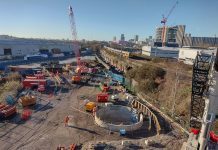Dairy operations – involving the processing and packaging of up to one billion litres of milk a year – are energy and water intensive procedures, producing hundreds of cubic metres of high strength wastewater every day.
The UK’s largest dairy company has made a commitment to reducing its environmental impact and becoming a pioneer in sustainable development, working towards the world’s first zero carbon dairy facility. Plans for a £150 million dairy offered the perfect opportunity to find innovative solutions to energy and water requirements, helping to reduce the net carbon dioxide contribution from power supplied to the plant. The dairy’s facility management company brought Veolia Water Technologies (Veolia) on-board to help develop a wastewater treatment solution in line with the company’s ambitious plans.
A zero carbon operation is a challenging target; producing one litre of milk requires the equivalent volume of water, it generates vast amounts of low and high strength wastewater and solid waste, and has considerable power demands. Veolia’s solution needed to consider all of these factors, as well as ensuring that all effluent discharge adhered to specifications set by the local water authority.
The top priority was to look at recycling and reusing water to reduce environmental and financial costs, starting with cleaning low strength and grey water via a reverse osmosis plant and returning recovered water to the dairy for clean-in-place (CIP) before being reused. Treating medium and high strength wastewater from milk production, however, is a more complicated process, and Veolia tackled the project by designing, supplying and commissioning a waste to energy facility in three phases.
The project would make use of Veolia’s technology in a staged process to produce effluent suitable for sewer discharge, while generating biogas and fertiliser as by-products and saving on waste disposal costs. The biogas would then be used as on-site fuel at the plant’s Combined Heat and Power (CHP) system or as a heat energy supply to the milk production process, while the nutrient-rich biomass would be harvested and used as a substitute for land fertiliser by local famers.
The first phase saw a Memthane® anaerobic membrane bioreactor (AnMBR) installed, offering cost-effective treatment of high strength wastewater within a small 75 square metre footprint. The patented, cutting-edge technology was developed by Biothane – part of the Veolia group – and is central to the wastewater treatment. The reactor sits within a system of components, including an equalisation tank, ultrafiltration membrane banks and polishing units, and significantly reduces operation costs compared to conventional technologies. In this case, the design was built to handle 500 cubic metres of wastewater every day, containing 5.5 tonnes of chemical oxygen demand (COD) – a measure of the oxygen required to decompose organic matter and oxidise the inorganic chemicals in water. The effluent is effectively free from suspended solids thanks to the small pore size of the ultrafiltration membranes, and meets stringent regulated consent limits for sewer discharge.
The treatment system was monitored during the first year of phase one operation, and the collated data revealed information about the wastewater characteristics and increased volume demands that was used to inform the second phase. As a result, the system was upgraded to handle a daily capacity of 800 cubic metres of wastewater, containing 8.7 tonnes of COD, and aerobic stages – reliant upon Veolia’s ANITA™ Mox and Dissolved Air Flotation (DAF) technology – were added at the end of the process to reduce levels of ammonia and phosphate in the sewer discharge. In addition, a second reactor was installed to ensure milk production continuity in the event of a reactor failure, and offer resilience and robustness.
The final phase turned the focus on the company’s solid waste digestion plant, which generates energy from treating out-of-date returns from its extensive customer base. Veolia developed the interface between the digestion plant and Memthane reactor to transport biogas and water to the plant, where the water aids in the digestion process and the biogas is returned to the grid as gas or electricity.
Since its completion in 2015, the dairy plant has shown that a combination of good planning and advanced process technologies can go a long way towards achieving the zero carbon goal.
Veolia’s wastewater treatment solution has reduced COD in wastewater by more than 99 per cent, and produced between 0.6 and 0.7 normal cubic metres of biogas per kilogram of COD removed. The design has enabled the dairy to successfully manage varying volumes and strengths of wastewater, as well as reduce its reliance on external power, all while supporting the development of new products.







